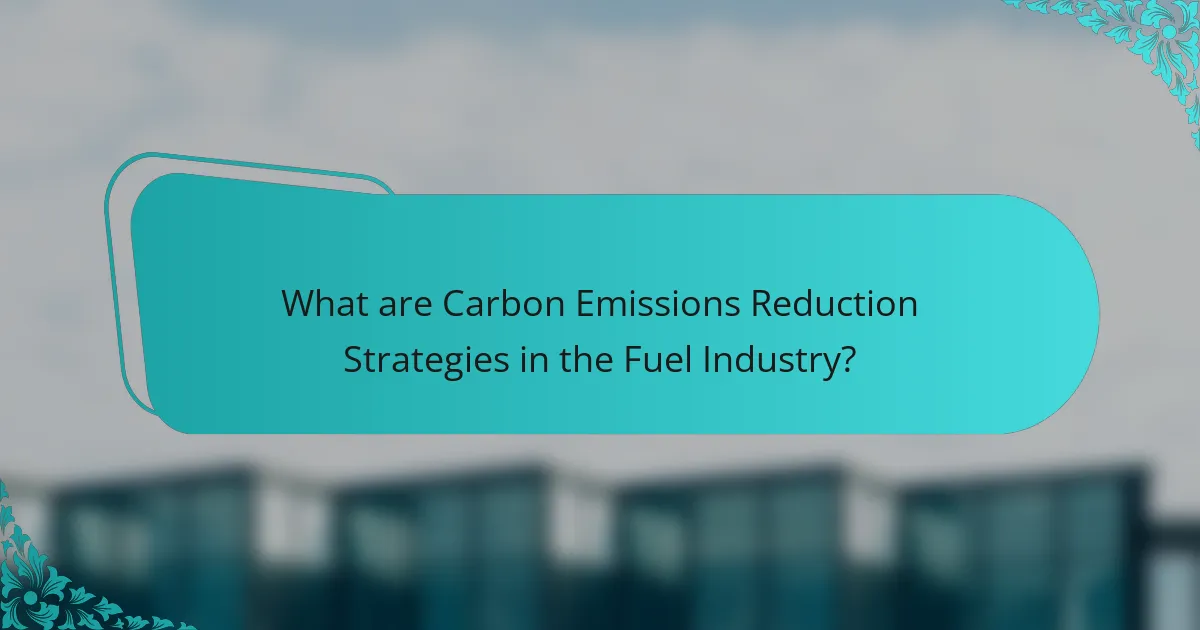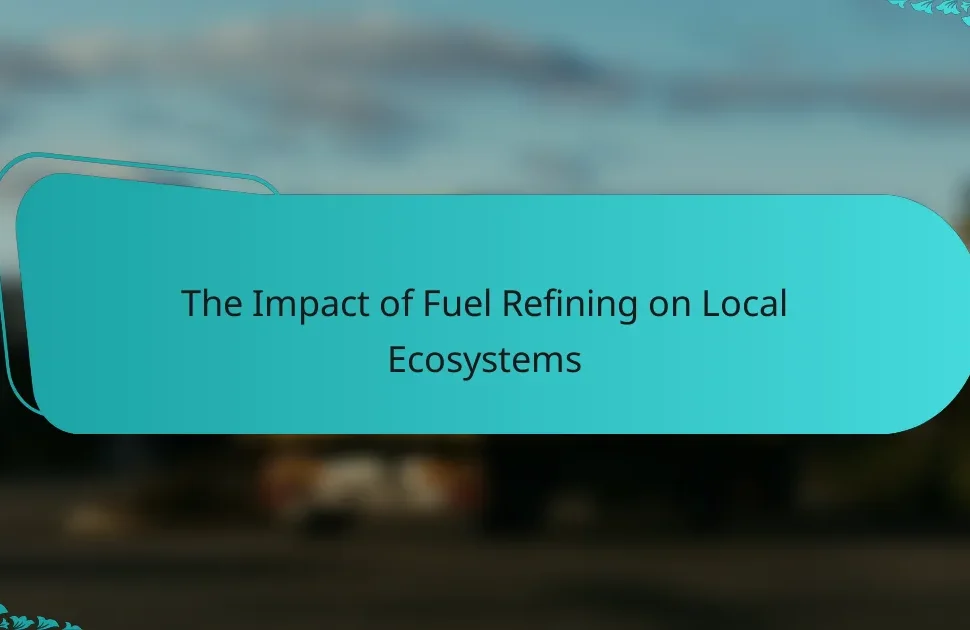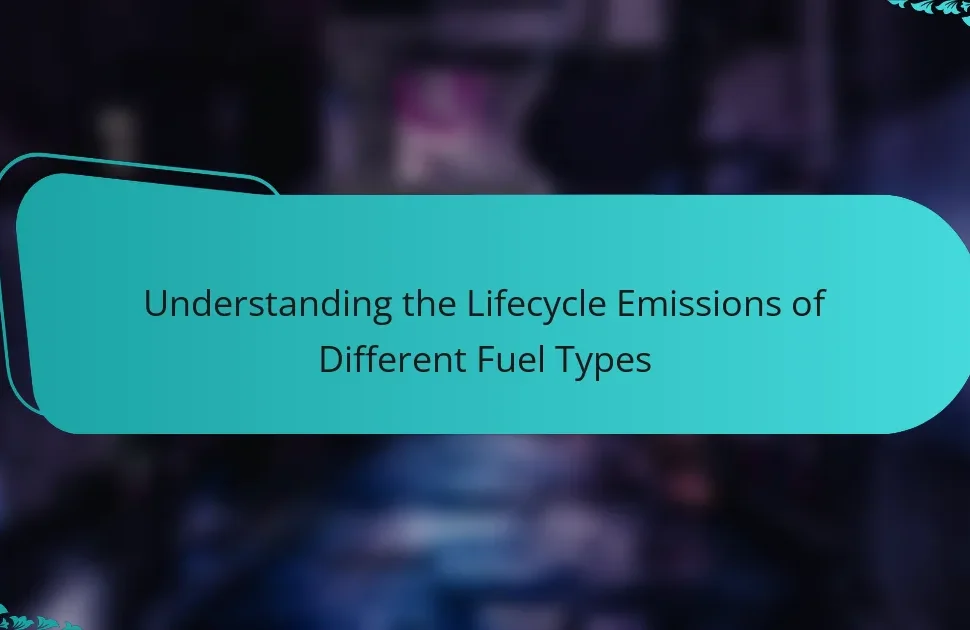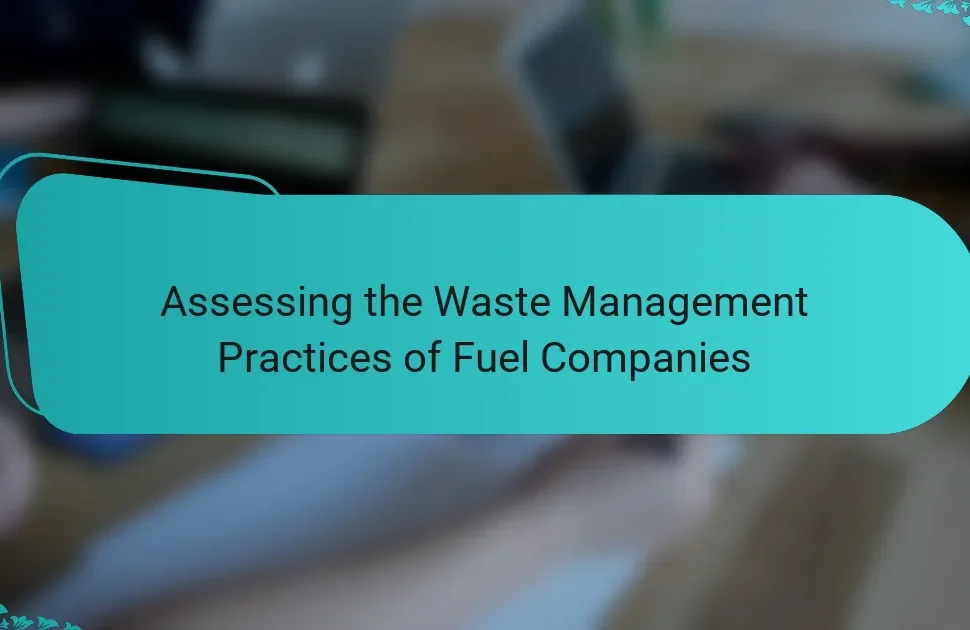
What are Carbon Emissions Reduction Strategies in the Fuel Industry?
Carbon emissions reduction strategies in the fuel industry include various methods aimed at decreasing greenhouse gas emissions. These strategies encompass improving fuel efficiency, adopting cleaner fuels, and implementing carbon capture and storage technology.
Fuel efficiency improvements can reduce emissions by optimizing combustion processes and enhancing engine designs. Cleaner fuels, such as biofuels and hydrogen, produce fewer emissions compared to traditional fossil fuels. Carbon capture and storage technology captures CO2 emissions from fuel combustion and stores it underground, preventing its release into the atmosphere.
According to the International Energy Agency, transitioning to low-carbon fuels can significantly lower emissions in the transportation sector. The adoption of these strategies is crucial for meeting global climate targets and reducing the impact of climate change.
Why is it important to reduce carbon emissions in the fuel industry?
Reducing carbon emissions in the fuel industry is crucial for mitigating climate change. The fuel industry is a major contributor to global greenhouse gas emissions. According to the International Energy Agency, it accounts for nearly 70% of total CO2 emissions from energy use. High carbon emissions lead to global warming, which results in severe weather events and rising sea levels. Additionally, reducing emissions improves air quality and public health. Studies show that cleaner air can decrease respiratory diseases and healthcare costs. Transitioning to low-carbon fuels can also drive innovation and economic growth in renewable energy sectors. Therefore, lowering carbon emissions is essential for environmental, health, and economic reasons.
What are the environmental impacts of carbon emissions from the fuel industry?
Carbon emissions from the fuel industry significantly contribute to climate change. These emissions lead to increased greenhouse gas concentrations in the atmosphere. Consequently, global temperatures rise, causing severe weather patterns. Rising temperatures also result in melting ice caps and rising sea levels. This threatens coastal communities and ecosystems. Furthermore, carbon emissions contribute to air pollution. Poor air quality impacts human health, leading to respiratory diseases. According to the World Health Organization, air pollution causes approximately 7 million deaths annually. Thus, the environmental impacts of carbon emissions from the fuel industry are profound and far-reaching.
How do carbon emissions affect public health?
Carbon emissions negatively affect public health by contributing to air pollution and climate change. Exposure to carbon emissions leads to respiratory issues, cardiovascular diseases, and premature death. The World Health Organization estimates that outdoor air pollution, primarily from combustion processes, causes approximately 4.2 million premature deaths annually. Carbon emissions also exacerbate climate change, which increases the frequency of extreme weather events. These events can lead to injuries and mental health issues. Vulnerable populations, such as children and the elderly, are particularly at risk. Reducing carbon emissions is essential for improving public health outcomes and enhancing overall well-being.
What are the key strategies for reducing carbon emissions in the fuel industry?
Key strategies for reducing carbon emissions in the fuel industry include transitioning to renewable energy sources, improving energy efficiency, and adopting carbon capture technologies. Transitioning to renewable energy sources, such as wind, solar, and biofuels, can significantly decrease reliance on fossil fuels. Energy efficiency improvements in extraction, refining, and transportation processes can reduce overall emissions. Additionally, implementing carbon capture and storage (CCS) technologies can capture emissions before they enter the atmosphere. According to the International Energy Agency, these strategies could potentially reduce emissions by up to 70% by 2050.
What role do renewable energy sources play in carbon emissions reduction?
Renewable energy sources significantly reduce carbon emissions. They generate electricity without burning fossil fuels. This process minimizes greenhouse gas emissions. According to the International Energy Agency, renewable energy could account for 80% of global electricity by 2050. This transition can lead to a reduction of up to 70% in CO2 emissions from the power sector. Additionally, renewable sources like wind and solar have a lower lifecycle carbon footprint compared to fossil fuels. The adoption of renewables also encourages energy efficiency and sustainable practices across industries. Thus, integrating renewable energy is crucial for achieving carbon neutrality targets.
How can fuel efficiency improvements contribute to lower emissions?
Fuel efficiency improvements can significantly lower emissions by reducing the amount of fuel consumed. When vehicles or machines operate more efficiently, they burn less fuel for the same amount of work. This decrease in fuel consumption directly correlates to lower carbon dioxide emissions. For instance, a study by the U.S. Environmental Protection Agency indicates that improving fuel efficiency by just one mile per gallon can reduce greenhouse gas emissions by about 25 million metric tons annually. Therefore, enhancing fuel efficiency not only conserves resources but also plays a crucial role in mitigating climate change.
What are the challenges faced in implementing carbon emissions reduction strategies?
Implementing carbon emissions reduction strategies faces several challenges. One major challenge is the high cost of transitioning to cleaner technologies. For instance, renewable energy sources often require significant upfront investment. Another challenge is the regulatory environment, which can be inconsistent and complex. This inconsistency may hinder the adoption of new practices. Additionally, there is resistance from stakeholders who may prioritize short-term profits over long-term sustainability. The need for extensive infrastructure changes also complicates implementation. For example, existing fuel distribution systems may not accommodate new energy sources efficiently. Lastly, public perception and awareness play a critical role. Many consumers may be unaware of the benefits of carbon reduction strategies, affecting demand for cleaner options.
What regulatory barriers exist for the fuel industry?
Regulatory barriers for the fuel industry include stringent emission standards and licensing requirements. These regulations aim to limit carbon emissions and promote environmental sustainability. Compliance with these standards often requires significant investment in technology and infrastructure. Additionally, the fuel industry faces complex permitting processes that can delay project timelines. Local, state, and federal regulations can vary widely, adding to the complexity. Regulatory uncertainty may deter investment in new fuel projects. Furthermore, international agreements on climate change impose additional compliance requirements on fuel producers. These barriers collectively impact the operational flexibility and profitability of the fuel industry.
How does market demand influence emissions reduction efforts?
Market demand significantly influences emissions reduction efforts by driving the adoption of cleaner technologies. When consumers prioritize environmentally friendly products, companies respond by investing in sustainable practices. This shift can lead to innovations in fuel efficiency and renewable energy sources. For example, a report by the International Energy Agency states that increased demand for electric vehicles has accelerated battery technology advancements. Additionally, regulatory frameworks often align with market trends, encouraging firms to reduce emissions to remain competitive. Thus, higher market demand for low-carbon options directly correlates with enhanced emissions reduction initiatives in the fuel industry.
How can technology drive carbon emissions reductions in the fuel industry?
Technology can drive carbon emissions reductions in the fuel industry through advancements in cleaner fuel production and energy efficiency. Innovations like carbon capture and storage (CCS) can significantly lower emissions from fossil fuel power plants. For instance, the Global CCS Institute reports that CCS can reduce emissions by up to 90% in some facilities. Additionally, the implementation of biofuels derived from renewable sources helps decrease reliance on traditional fossil fuels. According to the U.S. Department of Energy, biofuels can reduce greenhouse gas emissions by up to 86% compared to gasoline. Furthermore, improvements in refining processes and equipment efficiency can lead to lower emissions during fuel production. The International Energy Agency states that energy efficiency measures could reduce global CO2 emissions by 1.8 gigatons annually in the fuel sector. Overall, technology plays a crucial role in transforming the fuel industry towards more sustainable practices.
What innovative technologies are being developed for emissions reduction?
Innovative technologies for emissions reduction include carbon capture and storage (CCS), renewable energy sources, and advanced biofuels. CCS captures carbon dioxide emissions from sources like power plants and stores it underground. Renewable energy technologies include solar, wind, and hydroelectric systems, which replace fossil fuel use. Advanced biofuels are produced from non-food biomass, reducing reliance on traditional fossil fuels. These technologies aim to lower greenhouse gas emissions significantly. According to the International Energy Agency, implementing these technologies could potentially reduce emissions by up to 70% by 2050.
How do carbon capture and storage technologies work?
Carbon capture and storage (CCS) technologies work by capturing carbon dioxide emissions from sources like power plants. The captured CO2 is then transported to a storage site. This site is typically a geological formation deep underground. The process begins with the separation of CO2 from other gases during combustion. After separation, the CO2 is compressed for transportation. It is then injected into geological formations, where it can be stored for long periods. Studies have shown that this method can significantly reduce greenhouse gas emissions. According to the Global CCS Institute, CCS can mitigate up to 14% of global emissions by 2050.
What are the economic implications of carbon emissions reduction strategies?
Carbon emissions reduction strategies have significant economic implications. These strategies can lead to increased operational costs for industries reliant on fossil fuels. Transitioning to cleaner technologies often requires substantial upfront investments. However, these investments can result in long-term savings through improved energy efficiency.
Additionally, carbon reduction initiatives can create new job opportunities in renewable energy sectors. For example, the International Renewable Energy Agency (IRENA) reported that the renewable energy sector employed over 11 million people worldwide in 2018.
Furthermore, implementing carbon pricing can generate government revenue, which can be reinvested in sustainable infrastructure. This revenue can support economic growth while promoting environmental sustainability.
In contrast, failure to adopt these strategies may result in economic penalties. Countries that do not comply with international climate agreements may face trade restrictions. Overall, the economic implications of carbon emissions reduction strategies are multifaceted, involving both costs and potential benefits.
How can investments in emissions reduction be justified economically?
Investments in emissions reduction can be justified economically through cost savings and regulatory compliance. Reducing emissions often leads to lower operational costs due to increased efficiency. For instance, energy-efficient technologies can decrease fuel consumption, resulting in significant savings.
Moreover, many governments impose carbon pricing or emissions trading systems. Companies that invest in emissions reduction can avoid these costs. According to a report by the International Energy Agency, investments in energy efficiency could yield savings of $1.8 trillion by 2030.
Additionally, public demand for sustainable practices is rising. Companies that adopt emissions reduction strategies can enhance their brand reputation and customer loyalty. This can translate to increased sales and market share.
In conclusion, the economic justification for investments in emissions reduction is supported by potential cost savings, regulatory advantages, and improved market positioning.
What are the potential costs and savings associated with these strategies?
The potential costs associated with carbon emissions reduction strategies in the fuel industry include initial investment in technology and infrastructure. For example, implementing carbon capture and storage (CCS) can cost between $50 to $100 per ton of CO2 captured. Operational expenses may also increase due to the need for ongoing maintenance and monitoring of new systems.
Savings can arise from reduced regulatory fines and compliance costs. Companies that invest in emissions reduction may also benefit from tax incentives and grants. According to the International Energy Agency, transitioning to low-carbon technologies can lead to a reduction in fuel consumption, resulting in long-term cost savings.
Furthermore, companies adopting these strategies may experience enhanced brand reputation, leading to increased market share. Overall, while upfront costs can be significant, the long-term savings and benefits often outweigh these initial investments.
What best practices can fuel companies adopt for effective emissions reduction?
Fuel companies can adopt several best practices for effective emissions reduction. Implementing energy efficiency measures is crucial. This can include upgrading equipment and optimizing processes to minimize energy consumption. Transitioning to renewable energy sources is another effective strategy. Utilizing solar, wind, or bioenergy can significantly reduce reliance on fossil fuels.
Investing in carbon capture and storage technology is also vital. This technology can capture emissions produced during fuel combustion and store them underground. Companies should also consider adopting cleaner fuels. Switching to fuels with lower carbon content can lead to substantial emissions reductions.
Regularly monitoring and reporting emissions is essential for accountability. This practice helps companies track progress and identify areas for improvement. Engaging in partnerships and collaborations can further enhance emissions reduction efforts. Working with other organizations can lead to shared knowledge and resources.
These practices are supported by various studies. Research indicates that companies implementing energy efficiency measures can reduce emissions by up to 30%. Transitioning to renewable energy can cut emissions by 50% or more in some cases.
How can companies measure their carbon footprint effectively?
Companies can measure their carbon footprint effectively by utilizing standardized frameworks. The Greenhouse Gas Protocol offers a comprehensive methodology for calculating emissions. This protocol divides emissions into three scopes: Scope 1 includes direct emissions from owned sources, Scope 2 covers indirect emissions from purchased electricity, and Scope 3 accounts for all other indirect emissions in the value chain.
To implement this, companies should first collect data on energy consumption, fuel usage, and waste generation. Accurate data collection is crucial for precise calculations. Next, companies can use carbon accounting software to analyze and report their emissions.
According to a 2020 report by the Carbon Trust, organizations that adopt these practices can reduce their carbon emissions by up to 30% within five years. Regularly reviewing and updating measurement practices ensures ongoing accuracy and alignment with industry standards.
What collaborative efforts can enhance emissions reduction goals?
Collaborative efforts that can enhance emissions reduction goals include partnerships between governments, industries, and NGOs. These collaborations can lead to shared resources and knowledge. Joint research initiatives can foster innovative technologies aimed at reducing emissions. Industry-wide coalitions can establish common standards for emissions reductions. Public-private partnerships can facilitate investments in clean energy infrastructure. Additionally, regional agreements can create frameworks for collective action on emissions. For instance, the Carbon Disclosure Project encourages transparency among companies regarding their emissions. This transparency can drive accountability and motivate further reductions.
What future trends are expected in carbon emissions reduction strategies in the fuel industry?
Future trends in carbon emissions reduction strategies in the fuel industry include the increased adoption of renewable energy sources. Renewable energy, such as wind and solar, is expected to replace fossil fuels significantly. The implementation of carbon capture and storage (CCS) technologies will also become more prevalent. CCS can reduce emissions from existing fuel sources by capturing CO2 before it enters the atmosphere. Additionally, advancements in hydrogen fuel technology are anticipated. Hydrogen can serve as a clean alternative to traditional fuels. The industry is likely to see stricter regulatory frameworks aimed at emissions reduction. These regulations will push companies to innovate and adopt cleaner technologies. Investment in electric vehicle infrastructure will increase, supporting the transition away from fossil fuels. Collectively, these trends indicate a shift towards more sustainable practices in the fuel industry.
How might policy changes shape the future of emissions reduction?
Policy changes can significantly shape the future of emissions reduction by establishing regulatory frameworks and incentives. These changes can enforce stricter emission limits on industries, driving innovation in cleaner technologies. For instance, policies like carbon pricing encourage companies to reduce their greenhouse gas emissions to lower costs. Research indicates that countries with robust emissions regulations have seen a 20% decrease in carbon output over the past decade. Additionally, government subsidies for renewable energy sources can accelerate the transition away from fossil fuels. Overall, effective policy changes create a structured environment that promotes sustainability and accountability in emissions reduction efforts.
What role will consumer behavior play in these strategies?
Consumer behavior will significantly influence carbon emissions reduction strategies in the fuel industry. Understanding consumer preferences can guide companies in developing sustainable products. For instance, a shift towards eco-friendly fuels reflects growing consumer demand for sustainability. Research shows that 66% of global consumers are willing to pay more for sustainable brands. This trend pressures companies to innovate and invest in cleaner technologies. Additionally, consumer behavior affects regulatory compliance, as informed customers advocate for stricter environmental policies. The fuel industry must adapt to these changing behaviors to remain competitive and relevant in a sustainability-focused market.
What practical steps can individuals and businesses take to support carbon emissions reduction in the fuel industry?
Individuals and businesses can support carbon emissions reduction in the fuel industry by adopting renewable energy sources. Transitioning to solar, wind, or biofuels significantly lowers carbon footprints. Implementing energy efficiency measures in operations also reduces overall fuel consumption. For instance, upgrading to energy-efficient machinery can lead to substantial savings in fuel use.
Encouraging the use of public transportation and carpooling can further decrease reliance on fossil fuels. Individuals can opt for electric or hybrid vehicles, which produce fewer emissions than traditional cars. Businesses can invest in carbon offset programs to compensate for their emissions.
Engaging in advocacy for stricter environmental regulations can promote industry-wide changes. Supporting research and development of cleaner technologies is also crucial. By taking these steps, both individuals and businesses can contribute to meaningful reductions in carbon emissions within the fuel industry.
Carbon emissions reduction strategies in the fuel industry encompass various methods aimed at decreasing greenhouse gas emissions, including improving fuel efficiency, adopting cleaner fuels, and implementing carbon capture and storage technology. These strategies are essential for mitigating climate change, as the fuel industry accounts for nearly 70% of total CO2 emissions from energy use. The article explores the importance of reducing emissions for environmental and public health, key strategies for achieving reductions, challenges faced in implementation, and the role of technology and consumer behavior in driving change. Additionally, it discusses future trends and practical steps that individuals and businesses can take to support emissions reduction initiatives.




